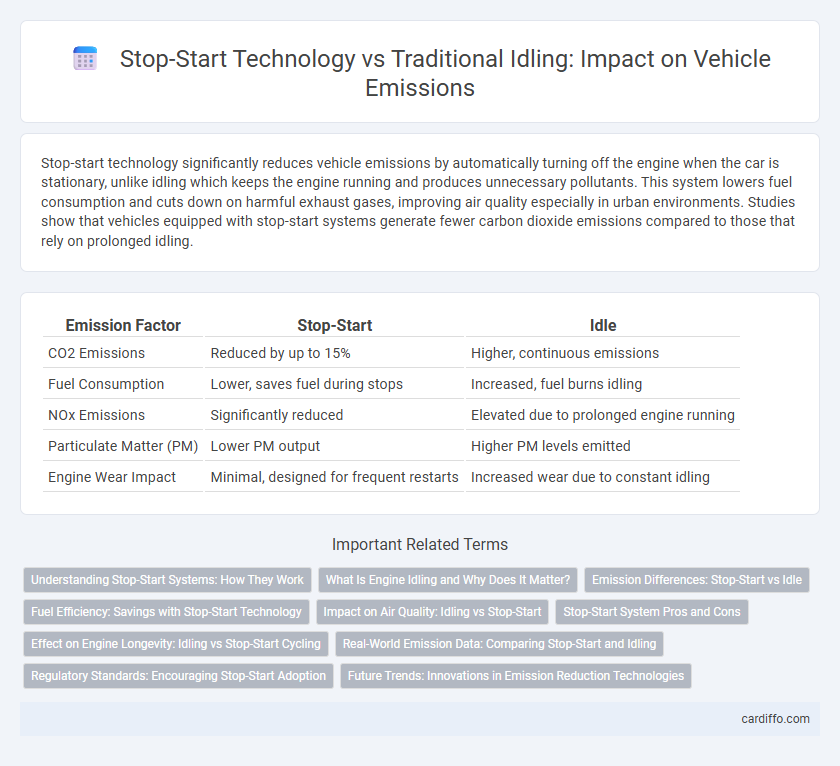Stop-start technology significantly reduces vehicle emissions by automatically turning off the engine when the car is stationary, unlike idling which keeps the engine running and produces unnecessary pollutants. This system lowers fuel consumption and cuts down on harmful exhaust gases, improving air quality especially in urban environments. Studies show that vehicles equipped with stop-start systems generate fewer carbon dioxide emissions compared to those that rely on prolonged idling.
Table of Comparison
| Emission Factor | Stop-Start | Idle |
|---|---|---|
| CO2 Emissions | Reduced by up to 15% | Higher, continuous emissions |
| Fuel Consumption | Lower, saves fuel during stops | Increased, fuel burns idling |
| NOx Emissions | Significantly reduced | Elevated due to prolonged engine running |
| Particulate Matter (PM) | Lower PM output | Higher PM levels emitted |
| Engine Wear Impact | Minimal, designed for frequent restarts | Increased wear due to constant idling |
Understanding Stop-Start Systems: How They Work
Stop-start systems reduce vehicle emissions by automatically shutting off the engine when the car is stationary and restarting it when the driver releases the brake. These systems optimize fuel consumption and lower carbon dioxide output, contributing to improved urban air quality. Advanced sensors and control units enable seamless engine restarts, minimizing idle time and associated pollutants.
What Is Engine Idling and Why Does It Matter?
Engine idling occurs when a vehicle's engine runs while the car is stationary, consuming fuel without movement and generating unnecessary emissions. This continuous fuel burn contributes significantly to air pollution and greenhouse gas accumulation, impacting urban air quality and climate change. Reducing engine idling through technologies like Stop-Start systems decreases fuel consumption and lowers harmful emissions, promoting environmental sustainability.
Emission Differences: Stop-Start vs Idle
Stop-start systems significantly reduce emissions by shutting off the engine during idle periods, thereby lowering fuel consumption and carbon dioxide output compared to traditional idling. Idling engines continuously emit pollutants such as nitrogen oxides (NOx) and particulate matter, contributing to increased air pollution and greenhouse gas levels. Vehicles equipped with stop-start technology demonstrate up to 10-15% reduction in overall CO2 emissions, enhancing urban air quality and supporting emission regulation compliance.
Fuel Efficiency: Savings with Stop-Start Technology
Stop-start technology significantly reduces fuel consumption by shutting off the engine during idle periods, preventing unnecessary fuel burn. Compared to traditional idling, this system can decrease fuel use by up to 10-15%, leading to substantial savings in urban driving scenarios with frequent stops. Enhanced fuel efficiency also contributes to lower carbon emissions, making stop-start systems a vital innovation for eco-friendly automotive solutions.
Impact on Air Quality: Idling vs Stop-Start
Stop-start technology significantly reduces harmful emissions by shutting off the engine during vehicle stops, which decreases the release of nitrogen oxides (NOx) and particulate matter compared to traditional idling. Idling engines produce continuous exhaust emissions, worsening urban air quality and contributing to smog formation and respiratory issues. Implementing stop-start systems can lead to measurable improvements in local air quality by minimizing pollutant concentrations in congested areas.
Stop-Start System Pros and Cons
Stop-start systems significantly reduce vehicle emissions by automatically shutting off the engine during stops, lowering fuel consumption and carbon dioxide output. However, frequent engine restarts can increase wear on starter motors and batteries, potentially raising maintenance costs. Despite these drawbacks, the system effectively decreases urban pollution and meets stricter emission regulations.
Effect on Engine Longevity: Idling vs Stop-Start Cycling
Stop-start systems reduce emissions by shutting off the engine during idle periods, which decreases fuel consumption and lowers pollutant output. However, frequent engine restarts can cause increased wear on components like the starter motor and battery, potentially impacting engine longevity. In contrast, extended idling maintains engine operation but leads to higher fuel usage and increased emissions, with less mechanical stress from starting cycles.
Real-World Emission Data: Comparing Stop-Start and Idling
Real-world emission data reveals that stop-start technology significantly reduces CO2 and NOx emissions compared to conventional idling in urban driving conditions. Studies indicate that vehicles equipped with stop-start systems achieve up to 15-20% lower fuel consumption, directly correlating with decreased greenhouse gas output during frequent stops. This emission reduction underscores the environmental benefits of integrating stop-start systems in modern vehicles for improved air quality and compliance with stricter emission standards.
Regulatory Standards: Encouraging Stop-Start Adoption
Regulatory standards increasingly promote stop-start technology to reduce vehicle emissions by minimizing engine idling times, which are a significant source of urban air pollution. Policies in the European Union and California enforce stricter emissions limits that incentivize automakers to integrate stop-start systems, thereby improving fuel efficiency and lowering CO2 output. Compliance with these regulations not only supports environmental goals but also accelerates market adoption of advanced stop-start mechanisms over traditional idling practices.
Future Trends: Innovations in Emission Reduction Technologies
Future trends in emission reduction technologies prioritize advanced stop-start systems that integrate artificial intelligence and predictive analytics to minimize fuel consumption and lower CO2 emissions more effectively than traditional idling. Innovations include hybrid electric powertrains and improved energy recovery mechanisms that enhance stop-start efficiency, significantly reducing urban pollution levels. Continuous development in sensor technology and real-time engine management further optimize emission control during vehicle stoppages, setting new standards for sustainable transportation.
Stop-Start vs Idle Infographic

 cardiffo.com
cardiffo.com